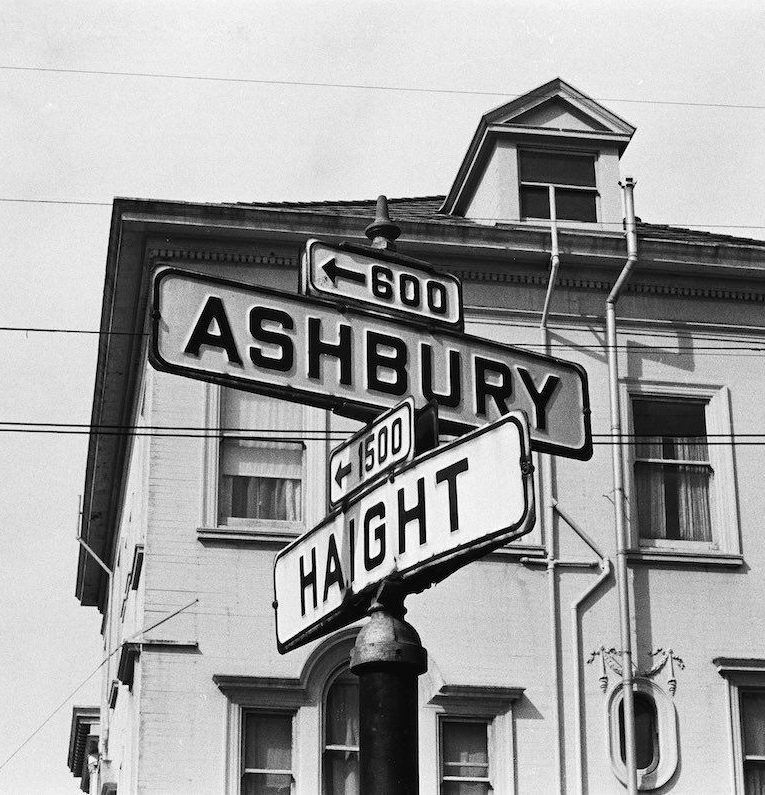thinking about counterculture history on the corner of haight & ashbury.

Reflections on a Summer 2023 Scholar-in-Residence experience at the SF Heritage Doolan-Larson Building in the Haight Ashbury neighborhood of San Francisco. From SF Heritage News, LI, 3 (October-December 2023).
In my first book, The Republic of Rock: Music and Citizenship in the Sixties Counterculture (Oxford University Press, 2013),and in many subsequent essays, articles, and talks, I examined the ways in which the Haight Ashbury became a globally significant place in the late 1960s. So, it seemed like fate that when I got into a taxi at San Francisco International airport in August of 2023 and said to the driver: “Take me to the corner of Haight and Ashbury.” Here I was reenacting the pilgrimage so many took to in the 1967 Summer of Love. However, I was not seeking to wear flowers in my hair (what hair?). I was in the Bay Area to serve as scholar-in-residence at San Francisco Heritage’s Doolan-Larson Building, located right at the historic corner of the Haight Ashbury neighborhood. The residency allowed me to conduct archival research on two projects: Anna Halprin‘s 1969 dancework Ceremony of Us, which saw her Bay Area-based Dance Workshop collaborate with an African American dance company in Watts, Los Angeles to explore race relations in America; and a proposed volume of selected essays by the countercultural social critic Theodore Roszak that I am developing with co-editor Peter Richardson, author of books about the Grateful Dead, Ramparts magazine, Hunter S. Thompson, Carey McWilliams, and currently working on a history of Rolling Stone magazine’s first 10 years.
The Halprin research took place in the archives of the Museum of Performance and Design and connects to an essay I am working on about how the 1960s countercultural milieu has things to teach us—some painful, some hopeful—about struggles over black-white cross-racial solidarity in today’s post-Black Lives Matter world.
The Roszak research reexamines this important but often forgotten writer. Roszak penned The Making of the Counter Culture: Reflections on the Technocratic Society and Its Youthful Opposition, a best-selling book from 1969 that gave the phenomena of so-called hippies in the Haight and elsewhere its very name. His papers at Stanford University’s Special Collections Library provide a vivid sense of Roszak’s wide-ranging work. By developing a volume of selected essays, Peter Richardson and I seek to show the breadth of Roszak’s critical perspective on everything from the peace movement to environmental issues to gender equality to the politics of science to the early Silicon Tech industry, and much more. Here is a thoughtful voice from “back then,” starting in the 1960s, that has something to say to the twenty-first century—even to those who care not one whit about hippies and the counterculture.
Being at the Doolan-Larson Building while conducting this research greatly enriched it, and not only for sheer ambiance. I was able to do things such as talk at length with artist-in-residence Seth Eisen, who with his group Eye Zen Presents was presenting a site-specific theatrical walking tour around the Haight about the amazing performer Sylvester. Seth and I were able to discuss the intersections of historical research and theatrical performance. It was a reminder that we access history from many angles. Particularly with the experiential qualities that mark the history of the Haight, hippies, and the broader counterculture, it is imperative we do so.
Overall, I was thrilled to get to spend two weeks in Norman Larson’s former apartment at the Colonial Revival building he owned, which housed important late 1960s shops such as Peggy Caserta’s Mnasidika, the clothing store that gave the world bell bottoms. It was an inspiring base from which to pursue my research in the City by the Bay.
Kramer-Doolan-Larson-SF-Residency-Halprin-Rozak-Summer-2023PDF.